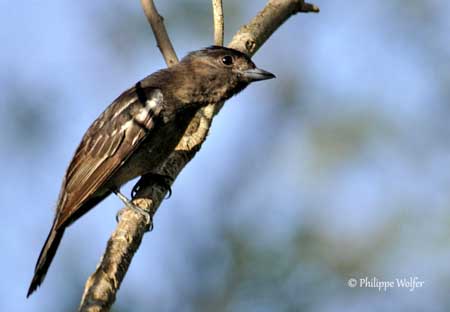
Text by Nicole Bouglouan
Photographers :
Roger Ahlman
Pbase Galleries Peru and Ecuador & My bird pictures on IBC
Didier Buysse
Vision d’Oiseaux
Marc Chrétien
MURINUS
Maxime Dechelle
LEPAPARRAZO
Steve Garvie
RAINBIRDER Photo galleries
Patrick Ingremeau
TAMANDUA
Philippe et Aline Wolfer
OISEAUX D'ARGENTINE
Sources :
HANDBOOK OF THE BIRDS OF THE WORLD Vol 9 - by Josep del Hoyo - Andrew Elliot - David Christie - Lynx Edicions - ISBN: 8487334695
A GUIDE TO THE BIRDS OF MEXICO AND NORTHERN CENTRAL AMERICA by Steve N. G. Howell, Sophie Webb - Oxford University Press - ISBN: 0198540124
A GUIDE TO THE BIRDS OF COLOMBIA by Steven L. Hilty and William L. Brown - Princeton University Press – ISBN 069108372X
PORTRAITS D’OISEAUX GUYANAIS - Groupe d'étude et de protection des oiseaux en Guyane (GEPOG) - Ibis rouge éditions - ISBN: 2844501842
TYRANNIDAE FAMILY
Subfamily Tityrinae
Becards and Tityras
The three genera of this subfamily are placed at the end of the Tyrannidae family, and this position is far from clear!
The large genus Pachyramphus includes 17 species of becards.
Becards are strange birds with swollen bicoloured bill, unique feature in Tyrannidae. Another rare character is that several species show sexual dimorphism.
Males are often black, black-and-white or grey, whereas females are brown. Their size is between 15 and 18 centimetres of length.

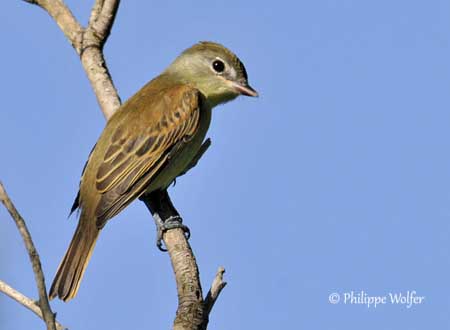
White-winged Becard
Pachyramphus polychopterus
All becards build huge, bulky nest with side entrance. Such nests can be suspended from overhanging branches, but they are sometimes braced on to fork of horizontal branch.
Becards feed mainly on insects, and occasionally small fruits. The foraging behaviour is very similar to that of Tyrannidae, with short-distance sallies from perches, hover-gleaning and sally-striking. Some acrobatic chases are observed too.
The Green-backed Becard (Pachyramphus viridis) forages at varying heights in open parts of trees and performs short distance sallies from perch to snatch preys.
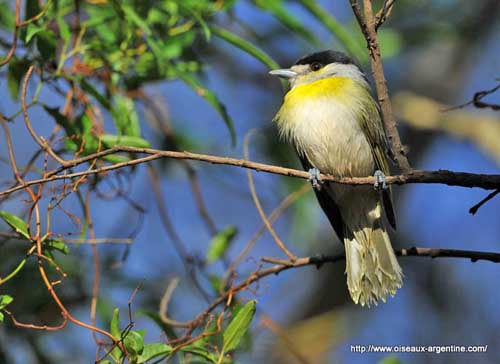
Green-backed Becard
Pachyramphus viridis
The Cinereous Becard (Pachyramphus rufus) builds a bulky, globular nest with side entrance, made with leaves and grass, and placed in fork among the outer branches in tree.
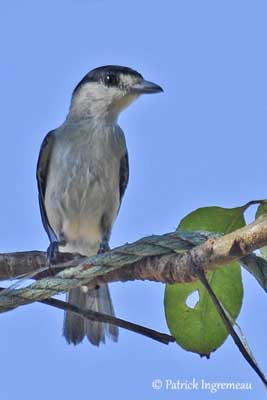
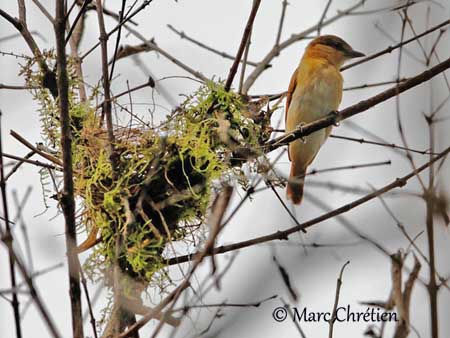
The Cinnamon Becard (Pachyramphus cinnamomeus) utters typical song, plaintive, often fast or trilled series of musical notes.
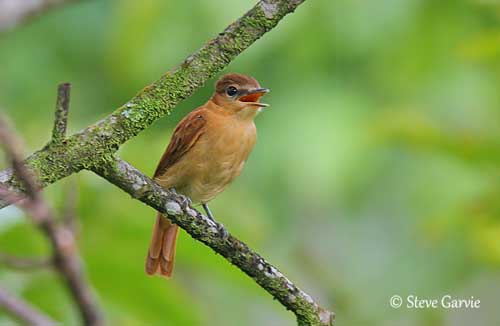
Cinnamon Becard
Pachyramphus cinnamomeus
The Rose-throated Becard (Pachyramphus aglaiae) feeds on insects, but also consumes considerable quantities of small fruits and seeds. It is often seen singly or in pairs, but it sometimes joins mixed-species flocks.
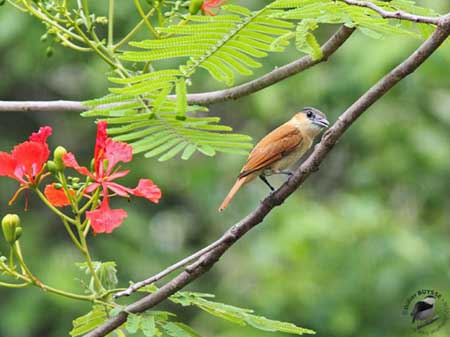
Rose-throated Becard
Pachyramphus aglaiae
In the Pink-throated Becard (Pachyramphus minor), male and female are very different. The male is black overall with rosy-pink patch on throat and upper breast. The female has greyish-brown crown, nape and back, contrasting with rufous wings and tail. Throat and underparts are buff.
The bulky nest is a globular mass suspended from tree-branch.
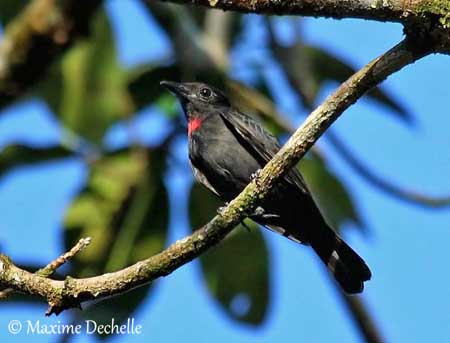
Becards occur mainly in the northern part of South America, but the Rose-throated Becard is found from SW USA, through Central America to NW Costa Rica. The Cinnamon Becard occurs from SE Mexico S to W Venezuela.
They are uncommon to fairly common, but the Slaty Becard (Pachyramphus spodiurus) is Endangered.
The White-naped Xenopsaris (Xenopsaris albinucha) is poorly known. This species is found in marshy and scrubby habitats, mainly along rivers. It occurs in N Argentina and Paraguay, and in open areas in C Venezuela.
This genus has been moved between Tyrannidae and Cotingidae too, but the compact cup-shaped nest is not that of becards, but could be a primitive character in Tyrannidae. Anatomical features resemble Pachyramphus, but for several reasons, this species has its own genus Xenopsaris.
The genus Tityra includes three species completely different from Tyrannidae. These birds occur in tropical forest. They are chunky, sluggish, with white body and black crown.
They have some internal anatomical features similar to Pachyramphus, Pipridae and Cotingidae.
The Masked Tityra (Tityra semifasciata) is present from NW Mexico, through Central America to NE Paraguay. This black-and-white bird shows black mask and bare pinkish-red facial skin and eye area. Wings and tail are black.
The female is duller with greyish mask and buffy-grey back.
They are mainly frugivorous, but they also take insects and occasionally small lizards. They perform sally-glean, taking large insects from foliage. They may hop heavily and slowly along branches, looking for preys and fruits.
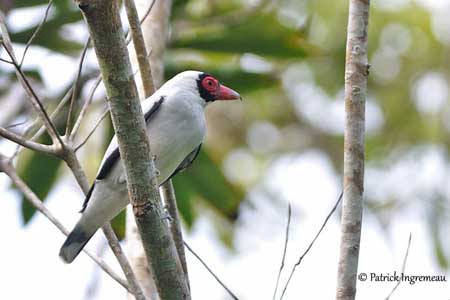
Masked Tityra
Tityra semifasciata
The Black-crowned Tityra (Tityra inquisitor) is present in the same range than the preceding one, but it reaches southwards NE Argentina.
It has black-and-white plumage with black head, but it lacks the reddish facial skin.
The female is rustier overall with black wings and tail, and she has chestnut or rusty head sides and black cap.
This species may be aggressive towards other birds, and is usually seen single, in pairs or in small groups. It perches on bare branch for long periods. It feeds on large insects and caterpillars, and consumes large fruits.
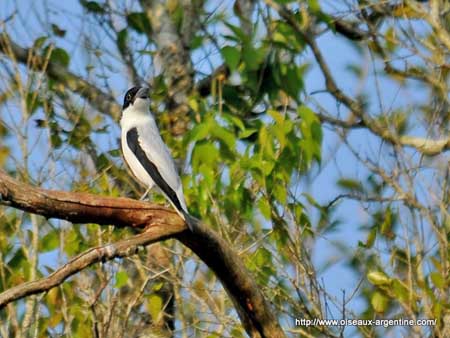
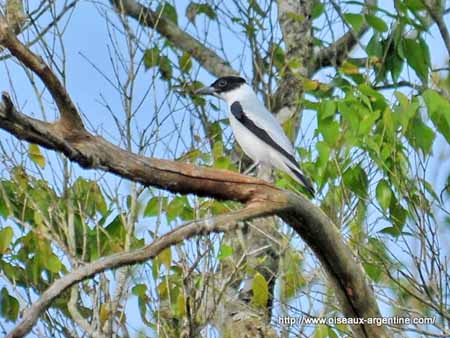
The Black-tailed Tityra (Tityra cayana) is present in the northern half of South America.
The male is black-and-white with pale greyish upperparts, black head and bare reddish facial skin on lores and around the eyes. Wings and tail are black.
The female has brownish crown. Her body is finely streaked black overall.
The diet is similar to that of previous species. They also are aggressive towards other species and often perch in the open on a bare limb.
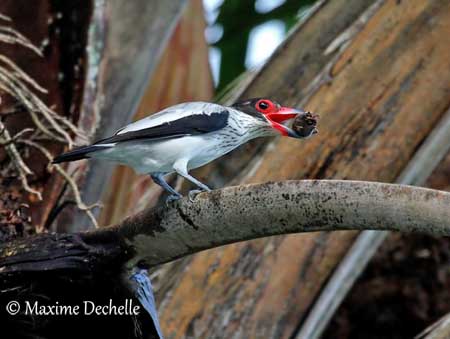
The Tityras nest in cavities, often old abandoned woodpecker holes. The cavity is filled with dead leaves, twigs and various other plant materials.
They are probably resident in their range, but the Masked Tityra is vagrant in S USA (S Texas).
These three species are fairly common or locally common in their range, and currently, they are not globally threatened.
Masked Tityra female
Tityra semifasciata
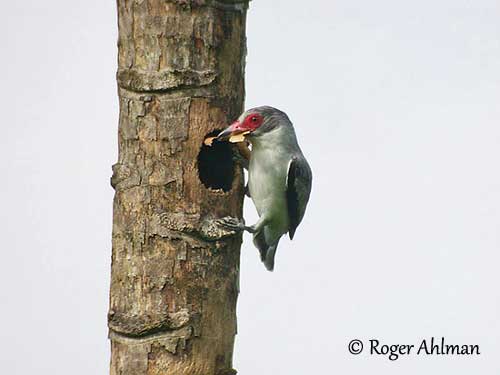
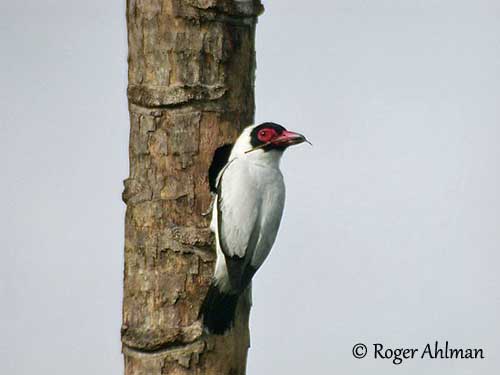
Masked Tityra male
Tityra semifasciata